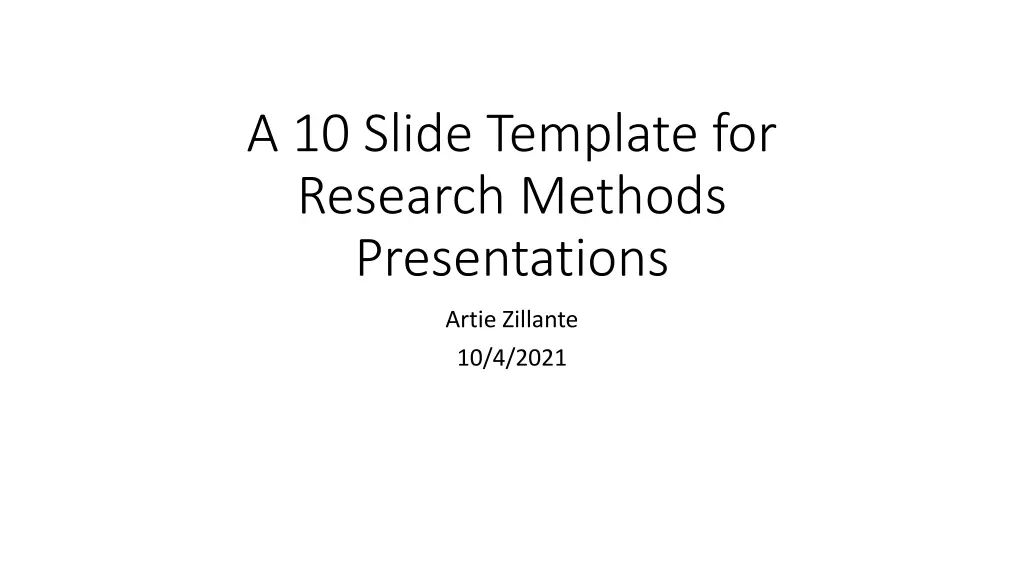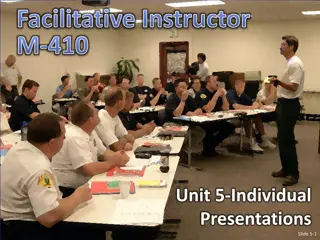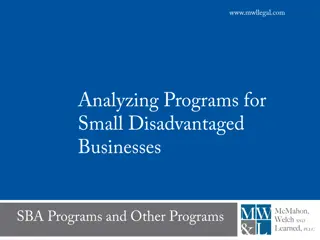
Slide Template for Research Methods Presentations
Enhance your research methods presentations with this 10-slide template. Grab your audience's attention with motivating visuals, present your findings early, and structure your background literature effectively. Share data summaries, discuss your model and empirical strategy, and present key results concisely. Anticipate and address questions by including a secret slide.
Download Presentation

Please find below an Image/Link to download the presentation.
The content on the website is provided AS IS for your information and personal use only. It may not be sold, licensed, or shared on other websites without obtaining consent from the author. If you encounter any issues during the download, it is possible that the publisher has removed the file from their server.
You are allowed to download the files provided on this website for personal or commercial use, subject to the condition that they are used lawfully. All files are the property of their respective owners.
The content on the website is provided AS IS for your information and personal use only. It may not be sold, licensed, or shared on other websites without obtaining consent from the author.
E N D
Presentation Transcript
A 10 Slide Template for Research Methods Presentations Artie Zillante 10/4/2021
Motivation/Research Question/Purpose You want to tell the listener very early in the presentation why they should be interested in your talk Could be something as simple as stating the research question Could use a picture to motivate a story Grab the listener s attention!
Findings Can combine with the previous slide Provide your findings early in the talk Do not make people wait to hear your findings Present your findings, and then explain how you arrived at those findings
Background Literature A number of ways to present the background literature Group by topic Group by finding Highlight an important paper or two Recommend against: Writing long sentences of text Providing a lot of details about prior work Your presentation time is short You want to focus on your work, not someone else s
Data Summary statistics Sources (particularly if they are nonstandard) CPS, PSID, NLSY, PWT those are fairly standard datasets that do not need much description I will show an example of a nonstandard dataset Anything that will help the listener understand your data
Model/Empirical Strategy Explain the models or empirical strategy that you are using You can write out the model formally Do not need to put why this model is appropriate on the slides; you can tell the audience that Variables that are being used
Results (be more specific in the title) Present the key results that you want to discuss and that tell your story Use the slide title to convey additional information (do not just put Results ) You should be able to anticipate and address questions You may want to have a secret slide at the end of the slide deck linked to slides where you think questions will arise
Results (be more specific in the title) Present any additional key results Same comments as the previous slide
Flex Slide(s) The 10 slide plan is a template, not an absolute How many slides you need for literature, data, model, and results will vary by topic With limited screen space, every word, symbol, etc. is important.
Conclusion Recap your findings Discuss limitations and paths for future studies (what open questions still exist)
MLB Rookie Card Values and Performance Uncertainty Gregory Burge Arthur Zillante Presented 10/4/2021
Motivation and Main Findings Exploit the role of information uncertainty to determine the influence of racial discrimination and statistical discrimination in MLB rookie card pricing Main Findings Counter to other studies, we find a premium for cards of Black players at the time of initial pricing After careers have concluded, no price premium for race/ethnicity once we control for career performance
Background Literature Discrimination in baseball card pricing exists (minority players underpriced) Nardinelli and Simon (1990); Andersen and La Croix (1991); Gabriel, Johnson, and Stanton (1999); Fort and Gill (2000); Burnett and VanScyoc (2004) No discrimination in baseball card pricing Regoli (1991); Gabriel, Johnson, and Stanton (1995); McGarrity, Palmer, and Poitras (1999); Burnett and VanScyoc (2012) Papers that focus on expectations using rookie card prices Gabriel, Johnson, and Stanton (1995, 1999)
Data Sources Beckett monthly and annual price guides Pricing data Rookie card designation The physical baseball cards Race/ethnicity determination, player position The Lahman Database (2011) and baseball-reference.com Player statistics, biographical data www.thebaseballcube.com and baseball-reference.com Data on player draft and signing status
Data Summary 6,026 total cards 20-fold increase from the largest of prior studies 1,910 distinct players Exclude 100-120 cards (no position, no final price available, unable to determine race/ethnicity for a dozen players) Prices Initial prices taken at the time of first available pricing (monthly price guide) for cards from 1986-1993 Final prices taken from annual guide 17 years later
Empirical Models Dependent Variable ln(Card Price/Common Card Price) Initial Price Model OLS with clustered SEs Race/ethnicity, rookie card designation, player and team effects Final Price Model OLS and Tobit Includes most variables as in initial price model Includes career performance statistics Necessitates separate models for hitters and pitchers Conducted a number of robustness checks
Initial Price Model Results All Players Hitters Pitchers Draft Binary Draft Rd. No controls Draft Binary Draft Rd. No controls Black 0.19*** 0.20*** 0.20*** 0.27*** 0.14* 0.16* 0.15 Hispanic 0.04 0.06 0.05 0.06 -0.02 -0.04 -0.04 Card controls Yes Yes Yes No Yes Yes No Demographics Yes Yes Yes No Yes Yes No Team controls Yes Yes Yes No Yes Yes No
Final Price Model Results Hitters Pitchers OLS Tobit OLS (no performance) OLS Tobit OLS (no performance) (performance) (performance) (performance) (performance) Black -0.02 -0.01 0.05 0.01 0.07 -0.08 Hispanic -0.04 -0.14 0.11 -0.03 -0.06 -0.14* Card controls Yes Yes Yes Yes Yes Yes Demographics Yes Yes Yes Yes Yes Yes Team controls Yes Yes Yes Yes Yes Yes Performance controls Yes Yes No Yes Yes No
Results from Both Models All Hitters Pitchers Draft Binary Draft Rd. No controls Draft Binary Draft Rd. No controls Black 0.19*** 0.20*** 0.20*** 0.27*** 0.14* 0.16* 0.15 Hispanic 0.04 0.06 0.05 0.06 -0.02 -0.04 -0.04 OLS (w/ perform) Tobit ( w/ perform) OLS (no perform) OLS (w/ perform) Tobit (w/ perform) OLS (no perform) Black -0.02 -0.01 0.05 0.01 0.07 -0.08 Hispanic -0.04 -0.14 0.11 -0.03 -0.06 -0.14*
Discussion Use the largest sample of baseball card prices to date focus on rookie cards 14-20% premium for cards of Black players in the initial pricing models finding runs counter to all previously published work No race effect present in final pricing models Why the premium in initial pricing for cards of Black players?
Gabriel, Johnson, and Stanton (1999) Another possible explanation for the observed results centers on customer expectations. Race might enter the formation of collector expectations when a player starts his career. If collectors perceive nonwhites to be better athletes than whites, they might expect that nonwhites will have superior career statistics compared to similar white players. However, some collectors may simultaneously have negative biases against nonwhites strictly based on race. At the beginning of a player s career, card value would then capture these two effects; the empirical issue is which effect would dominate. (1999:1334)
Robustness checks Randomly selected one card per player Used the highest valued card for each player Used the lowest valued card for each player (worst models) Included a binary for active players in the final price model RC designation in initial year matches final year
Initial Price Model More Results All Players Hitters Pitchers Draft Binary Draft Rd. No controls Draft Binary Draft Rd. No controls Black 0.19*** 0.20*** 0.20*** 0.27*** 0.14* 0.16* 0.15 Hispanic 0.04 0.06 0.05 0.06 -0.02 -0.04 -0.04 RC Initial 0.31*** 0.34*** 0.40*** 0.27*** 0.30*** XRC Initial 0.30*** 0.33*** 0.39*** 0.23*** 0.24*** Age at release -0.07*** -0.10*** -0.08*** -0.04*** -0.03*** Time since signed -0.04*** -0.03*** -0.05*** -0.04*** -0.04*** # of cards 0.07*** 0.07*** 0.07*** 0.06*** 0.05*** MLB 0.23*** 0.33*** 0.34*** 0.12*** 0.16*** experience
Final Price Model More Results Hitters Pitchers OLS Tobit OLS (no performance) OLS Tobit OLS (no performance) (performance) (performance) (performance) (performance) Black -0.02 -0.01 0.05 0.01 0.07 -0.08 Hispanic -0.04 -0.14 0.11 -0.03 -0.06 -0.14* RC Initial 0.63*** 1.62*** 0.45*** 0.45*** 1.69*** 0.32*** XRC Initial 0.68*** 1.62*** 0.52*** 0.38*** 1.41*** 0.26*** Age at release -0.03** -0.07*** -0.15*** -0.02** -0.08*** -0.08*** Time since signed -0.03** -0.07*** -0.05** -0.02* -0.07*** -0.05 # of cards 0.01 0.02 0.07*** -0.00 0.04** 0.05*** MLB -0.27*** -0.34*** -0.11 -0.21*** -0.31*** -0.03 experience






















